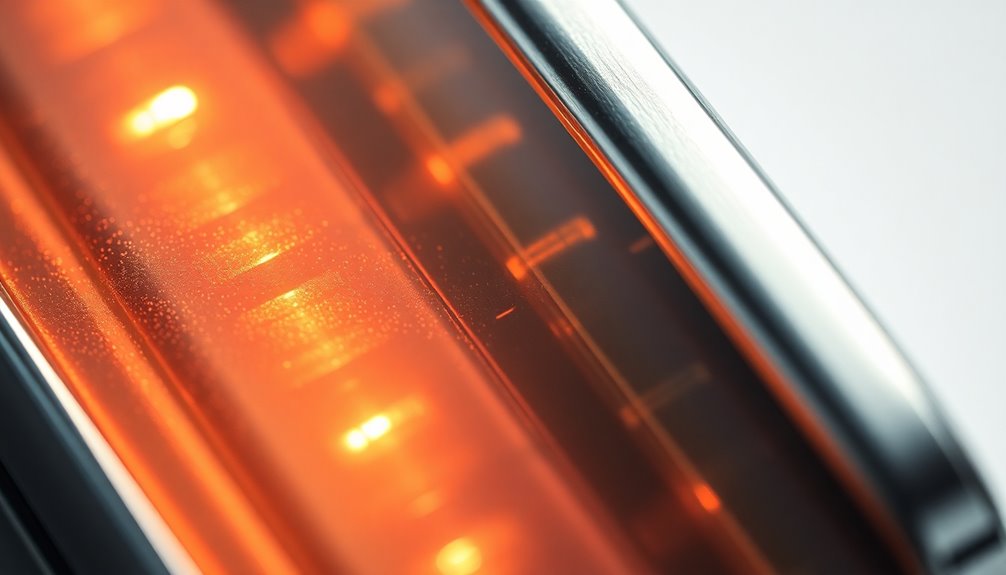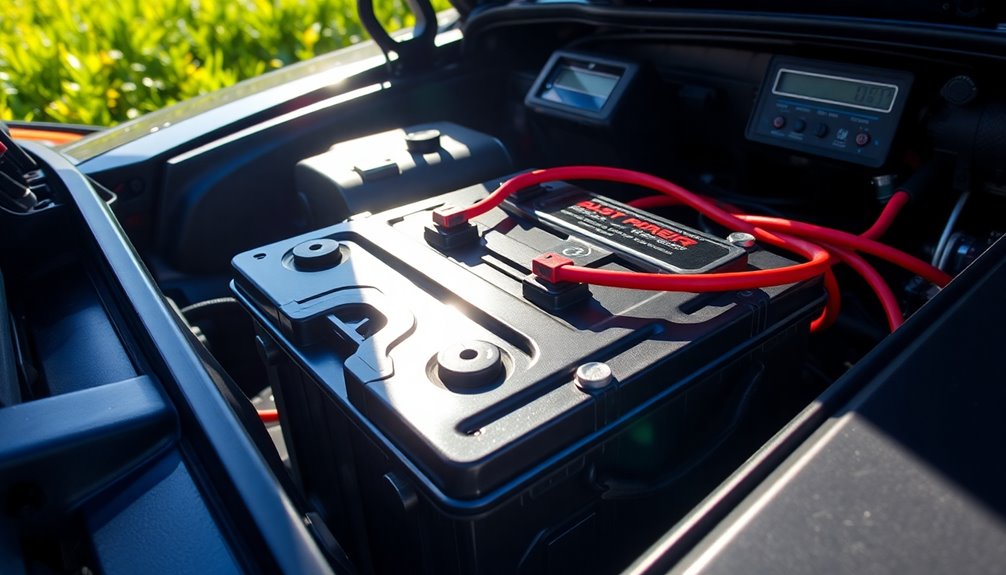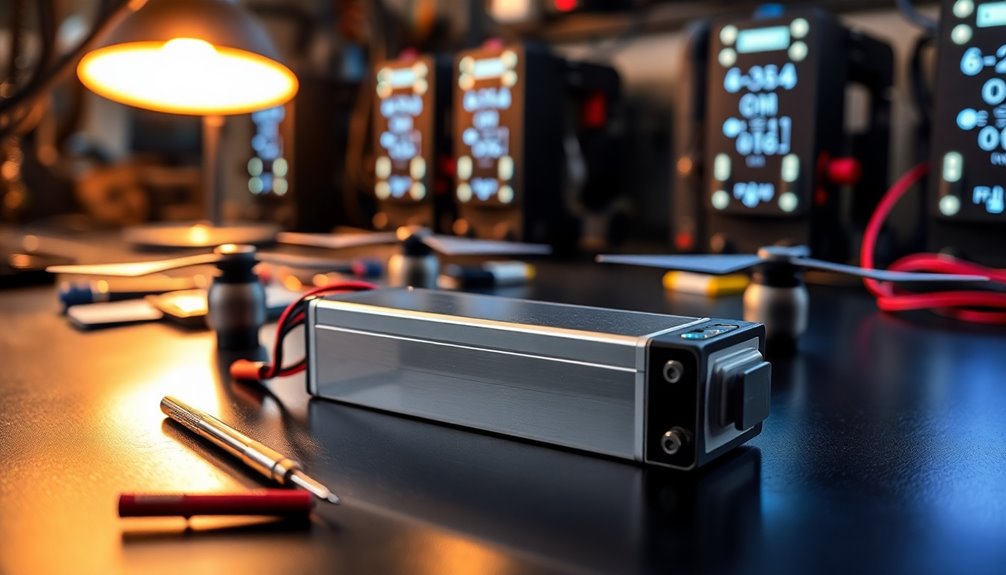Lithium-ion batteries power your devices by converting stored chemical energy into electrical energy. They consist of an anode, usually made of graphite, and a cathode, often lithium cobalt oxide. When charging, lithium ions move from the cathode to the anode while electrons travel through an external circuit. This flow generates electricity. The separator guarantees safety by preventing short-circuits while allowing lithium ions to pass. With their high energy density, long cycle life, and quick charging, they're a preferred choice for everything from smartphones to electric cars. Keep exploring to discover more about their fascinating technology and advancements!
Key Takeaways
- Lithium-ion batteries consist of an anode (graphite), cathode (usually lithium cobalt oxide), separator, and electrolyte (lithium salt in organic solvent).
- During charging, lithium ions move from the cathode to the anode, while electrons flow through an external circuit to provide power.
- The separator prevents short circuits by allowing lithium ions to pass through while blocking direct contact between the anode and cathode.
- These batteries operate at a nominal voltage of 3.7 V and offer high energy density, making them ideal for portable devices and electric vehicles.
- Innovations in battery technology, such as silicon anodes and solid-state electrolytes, enhance performance, safety, and lifespan of lithium-ion batteries.
Overview of Lithium-Ion Batteries
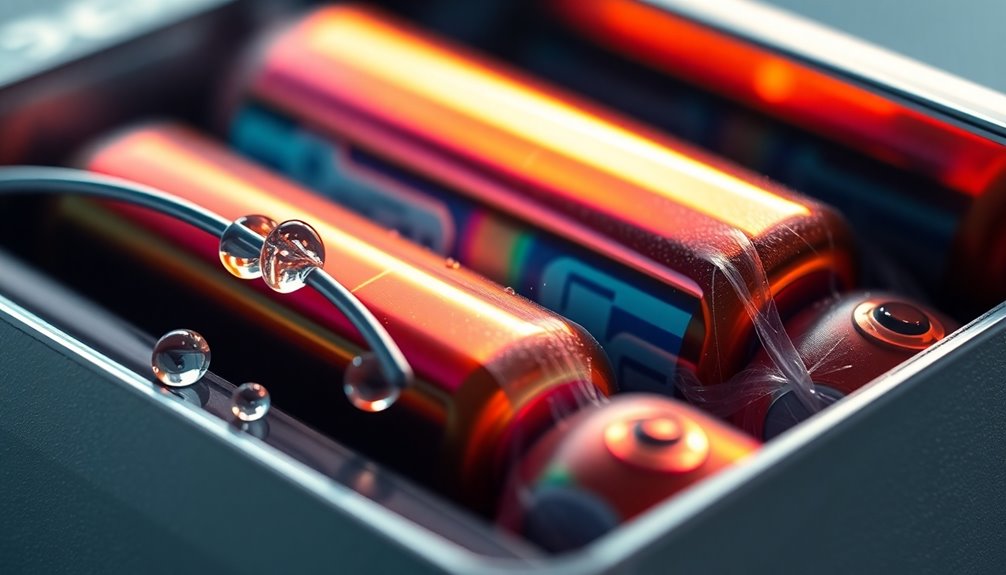
Lithium-ion batteries are an essential technology powering many of today's devices, from smartphones to electric vehicles.
These batteries consist of three main components: the anode, typically made of graphite; the cathode, commonly lithium cobalt oxide or lithium iron phosphate; and the electrolyte, a lithium salt in an organic solvent.
This composition allows for efficient ion movement during charge and discharge cycles. Operating at a nominal voltage of 3.7 V, lithium-ion batteries achieve higher energy density compared to traditional lead-acid batteries.
During charging, lithium ions migrate from the cathode to the anode through the electrolyte, while electrons flow through an external circuit.
With a low self-discharge rate and a cycle life exceeding 2,000 charge cycles, these batteries guarantee longevity and reliability for modern applications.
Historical Milestones in Battery Development
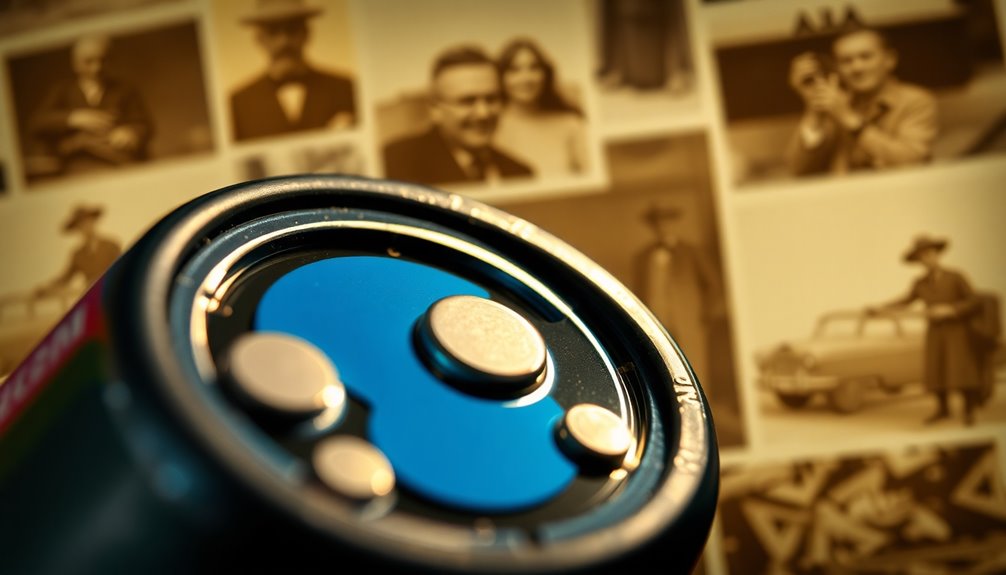
When you explore the history of lithium battery development, you'll uncover key innovations that shaped the technology we rely on today.
From the first lithium metal battery in 1970 to Sony's game-changing commercial release in 1991, each milestone marks a significant leap forward.
Understanding these breakthroughs highlights the ongoing advancements that continue to enhance battery performance and safety.
Pioneering Lithium Innovations
Since the introduction of the first lithium metal battery in 1970, the field of battery technology has experienced remarkable advancements.
These innovations have redefined energy storage and rechargeable battery systems, addressing safety issues while enhancing performance.
Here are some key milestones:
- 1980: John Goodenough introduces lithium cobalt oxide, doubling energy density.
- 1991: Sony and Asahi Kasei launch the first commercial lithium-ion battery, revolutionizing consumer electronics.
- 1990s-2000s: Development of lithium iron phosphate (LiFePO4) and lithium manganese oxide improves safety and lifespan.
- Present: Ongoing research into silicon anodes and solid-state electrolytes promises even better performance and safety for lithium-ion batteries.
These pioneering lithium innovations have shaped our reliance on high energy density batteries today.
Key Technological Advancements
Over the past few decades, battery technology has undergone transformative advancements that have redefined energy storage. The commercialization of lithium-ion batteries by Sony and Asahi Kasei in 1991 marked a pivotal moment, making portable energy storage more accessible.
Earlier, in the 1980s, John Goodenough introduced lithium cobalt oxide, which doubled energy potential and enhanced performance. Fast forward to the 1990s, and the development of lithium iron phosphate (LiFePO4) provided improved safety and longevity, addressing earlier concerns about rechargeable batteries.
Today, ongoing technology advancements include innovations like silicon anodes and solid-state electrolytes, further pushing the boundaries of performance and safety in lithium-ion batteries, ensuring they remain at the forefront of energy storage solutions.
Components of Lithium-Ion Batteries
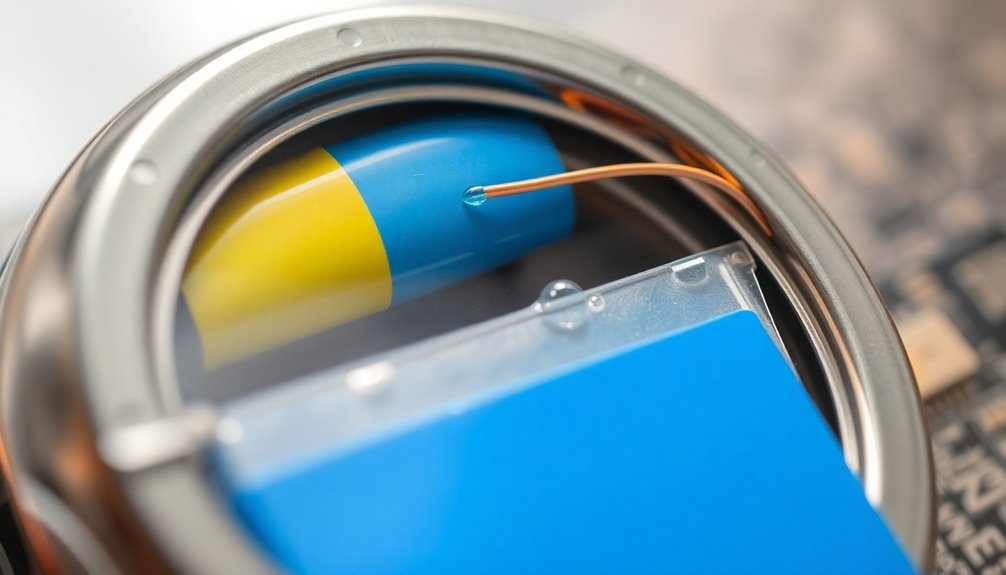
When you look at a lithium-ion battery, you'll notice it comprises four key components: the cathode, anode, separator, and electrolyte.
Each part plays an essential role in how the battery functions, especially the electrolyte, which allows lithium ions to move between the cathode and anode.
Understanding these components helps you appreciate the technology behind modern batteries.
Key Battery Components
Understanding the key components of lithium-ion batteries is essential for grasping how they function. These batteries rely on four main parts that work together seamlessly:
- Cathode: Typically made from lithium cobalt oxide or lithium iron phosphate, it releases lithium ions during discharge.
- Anode: Usually composed of graphite, it stores lithium ions while the battery charges.
- Electrolyte: A lithium salt dissolved in an organic solvent, it allows lithium ions to move between the anode and cathode, facilitating the electrochemical reaction.
- Separator: This vital component prevents short circuits by keeping the anode and cathode apart while allowing lithium ions to pass through.
Together, these components create a powerful, efficient energy source, ideal for many applications.
Electrolyte Functionality
The electrolyte is an essential component of lithium-ion batteries, enabling the movement of lithium ions between the anode and cathode during charge and discharge cycles. Typically, it consists of a lithium salt, like lithium hexafluorophosphate (LiPF6), dissolved in an organic solvent.
This combination not only acts as an ionic conductor but also greatly influences the electrochemical stability of the battery. By preventing unwanted side reactions, the electrolyte enhances overall performance and safety.
The choice of electrolyte composition can impact the battery's operating temperature range, allowing for effective performance even in extreme conditions. Advances in technology, such as polymer and gel electrolytes, aim to improve safety by reducing flammability while maintaining high ionic conductivity compared to traditional liquid electrolytes.
Charging and Discharging Mechanism
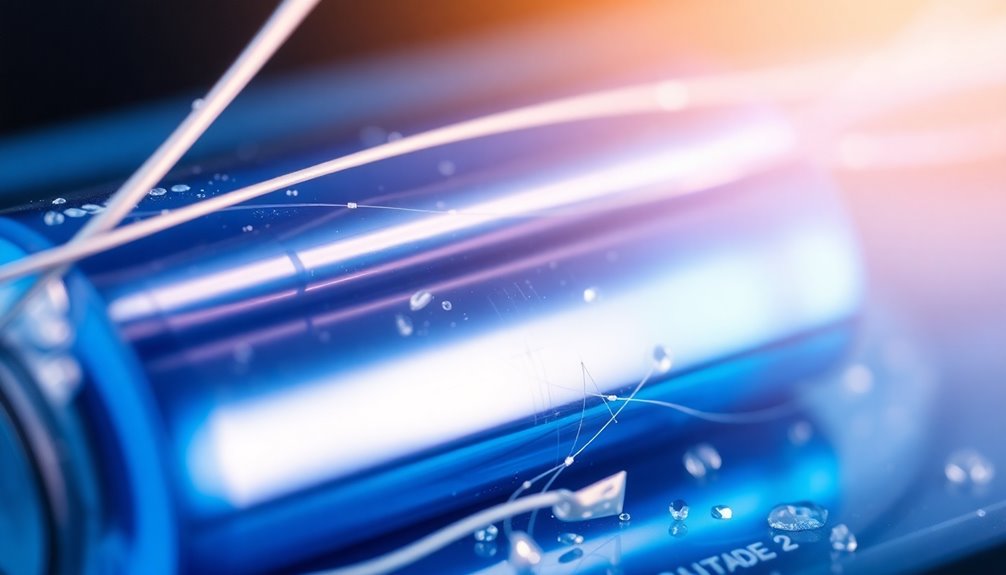
Charging and discharging lithium-ion batteries involves a fascinating interplay of lithium ions and electrons.
During charging, lithium ions migrate from the cathode to the anode, while electrons travel through the external circuit. Here's what happens step-by-step:
- Lithium ions move from the cathode (often lithium cobalt oxide) through the electrolyte.
- Electrons flow from the cathode to the anode via the external circuit.
- Lithiated graphite forms at the anode when fully charged.
- During discharging, lithium ions return to the cathode while electrons generate electrical energy.
This efficient process, aided by the high energy density of 150-200 Wh/kg and the reversible movement of ions, guarantees minimal degradation over multiple cycles.
It's this dynamic mechanism that powers your devices.
Advantages of Lithium-Ion Technology
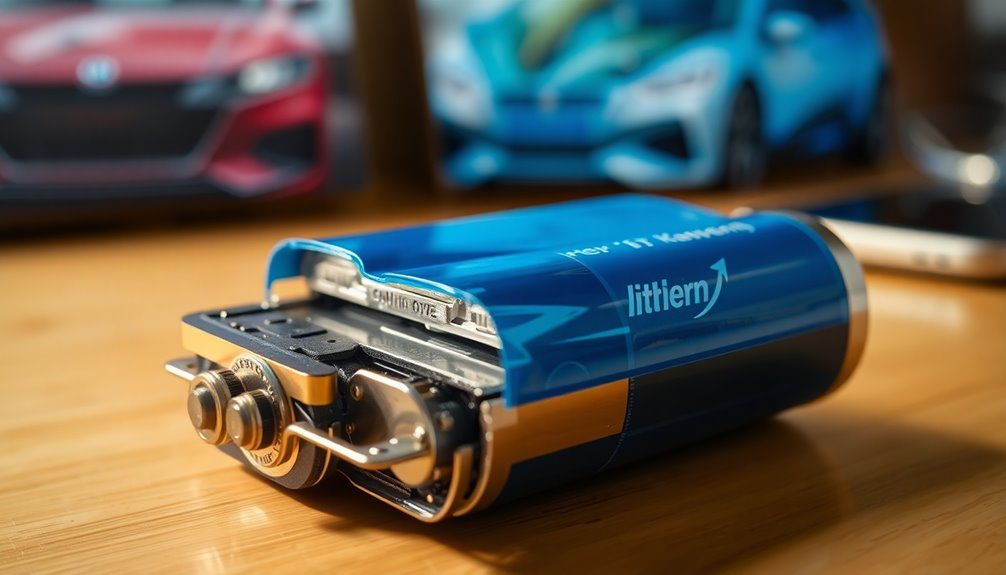
Lithium-ion technology stands out for its numerous advantages, making it a preferred choice for various applications, from smartphones to electric vehicles.
One of the key benefits is the high energy density of lithium-ion batteries, typically around 150-200 Wh/kg, allowing for lightweight and compact power storage.
Additionally, their long cycle life often exceeds 2,000 charge-discharge cycles, which helps lower replacement costs and reduces waste.
You'll also appreciate the low self-discharge rate of about 2-3% per month, ensuring your devices retain their charge for longer periods without use.
Plus, with fast charging capabilities, you can quickly power up your devices, fitting seamlessly into your busy lifestyle.
Comparison With Other Battery Types

When comparing battery technologies, you'll find that lithium-ion batteries offer distinct advantages over traditional options like lead-acid and nickel-cadmium.
Here's a quick breakdown:
- Energy Density: Lithium-ion batteries operate at 3.7 V, greatly outperforming lead-acid batteries at around 2.0 V per cell.
- Charge Cycles: They exceed 2,000 charge cycles, while lead-acid batteries last about 500 cycles.
- Self-Discharge Rate: Lithium-ion batteries self-discharge at just 1-2% per month, compared to 5-15% for lead-acid options.
- Design: Their lightweight, compact design is achieved through lithium compounds and graphite, unlike the bulkier lead-acid batteries.
These factors make lithium-ion batteries not only more efficient but also more reliable and user-friendly, ultimately enhancing your power storage experience.
Emerging Trends in Battery Innovation
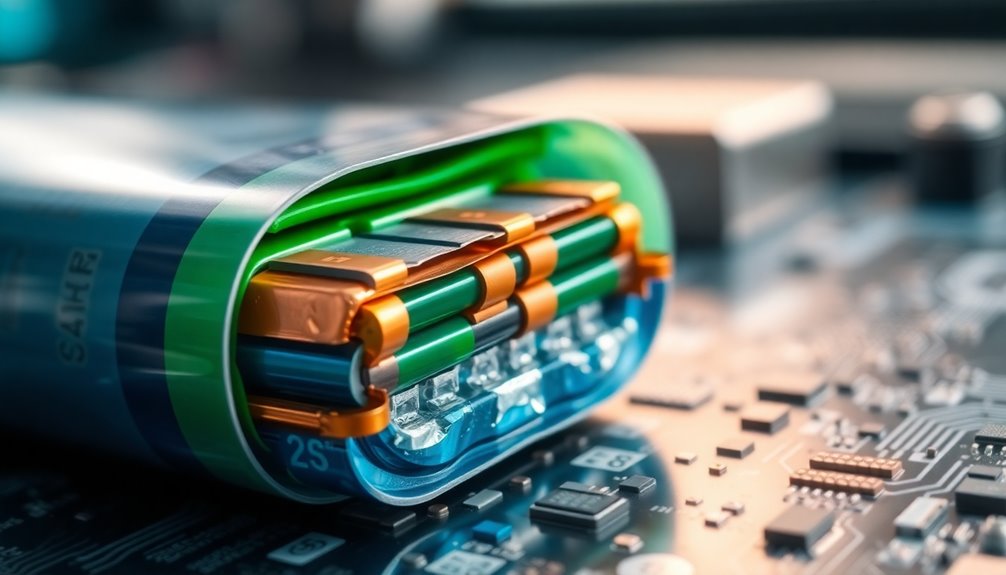
As researchers push the boundaries of battery technology, emerging trends promise to revolutionize energy storage solutions. Solid-state batteries are gaining attention for their enhanced energy density and safety. Lithium-sulfur batteries could offer lower costs and greater capacity, while advanced materials like silicon-based anodes improve cycling performance.
| Innovation Type | Key Features | Benefits |
|---|---|---|
| Solid-State Batteries | Solid electrolytes | Higher safety, reduced thermal risk |
| Lithium-Sulfur Batteries | Lower costs, higher capacity | Cost-effective, efficient energy storage |
| AI in Battery Systems | Performance optimization | Extended lifespan, health monitoring |
| Advanced Materials | 3D nanostructures, silicon anodes | Improved performance and capacity |
Integrating artificial intelligence into battery management systems optimizes performance, ensuring lithium-ion batteries work more efficiently.
Environmental Considerations
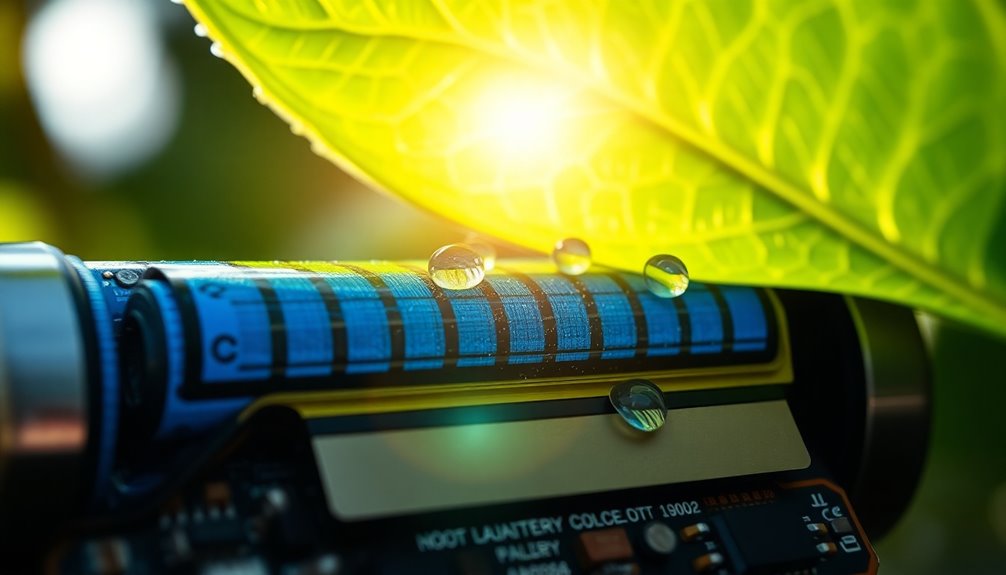
While lithium-ion batteries are often praised for their efficiency, it's essential to evaluate their environmental impact. Here are some key considerations:
- Reduced Toxicity: Unlike lead-acid batteries, lithium-ion batteries use fewer toxic materials, promoting a healthier environment.
- Recycling Efforts: The rise in lithium-ion battery usage has sparked increased recycling initiatives, recovering valuable materials like lithium and cobalt.
- Longevity: With over 2,000 charging cycles, these batteries can be optimized for sustainable energy, reducing waste.
- Extraction Concerns: However, lithium extraction can lead to water depletion and habitat disruption, which raises environmental concerns.
- Additionally, the recycling initiatives for lithium-ion batteries aim to minimize waste and promote sustainable resource management.
Future Directions in Battery Research

Given the rapid advancements in battery technology, researchers are diving into exciting new directions that promise to redefine lithium-ion batteries' future. They're investigating metastable states in various electrode materials to enhance performance beyond current limits.
Solid-state batteries are on the horizon, offering improved energy density and safety by utilizing solid electrolytes instead of liquid ones. Plus, artificial intelligence is being integrated into battery management systems, optimizing performance and lifespan while tackling charging speeds and efficiency.
Ongoing research into alternative materials like silicon and lithium-sulfur aims to reduce reliance on cobalt, boosting sustainability. Collaborative efforts combining theoretical modeling with experimental research will be essential in driving innovation and addressing the limitations of existing lithium-ion battery technologies.
Frequently Asked Questions
What Is the Science Behind Lithium-Ion Batteries?
The science behind lithium-ion batteries involves the movement of lithium ions between the anode and cathode during charging and discharging.
When you charge the battery, lithium ions migrate through the electrolyte to the anode, storing energy. During discharge, they flow back to the cathode, generating electricity.
This process relies on reversible chemical reactions, giving you a high energy density and long cycle life, making these batteries ideal for portable devices and electric vehicles.
How Do Lithium-Ion Batteries Release Their Energy?
You know what they say, "What goes up must come down."
In lithium-ion batteries, energy release happens when lithium ions move from the anode to the cathode. As these ions travel through the electrolyte, electrons flow through an external circuit, powering your devices.
This efficient process allows the battery to discharge energy, then recharge by sending ions back to the anode, ensuring you get consistent performance without significant wear over time.
What Is the Biggest Disadvantage of a Lithium-Ion Battery?
The biggest disadvantage of lithium-ion batteries is their risk of thermal runaway. If you don't manage them properly, they can overheat, potentially leading to fires or even explosions.
Additionally, these batteries degrade over time, lasting only 2 to 3 years or about 300 to 500 charge cycles.
You'll also find environmental issues with sourcing materials like lithium and cobalt, plus the higher initial costs may limit accessibility for some users.
How Bad Are Lithium Batteries for the Environment?
Imagine a beautiful forest, vibrant and alive, slowly choking under the weight of mining for lithium and cobalt.
You mightn't realize it, but lithium batteries can wreak havoc on the environment. Their production leads to habitat destruction and water depletion, while improper disposal creates toxic waste.
Although recycling options are improving, only a fraction of batteries gets recycled effectively.
It's essential you consider these impacts when choosing battery technology.
Conclusion
To sum up, understanding how lithium-ion batteries work not only enhances your appreciation for the technology but also reveals their crucial role in our daily lives. As you explore this dynamic field, you'll find that advancements are continuously reshaping energy storage. So, whether you're powering your smartphone or envisioning the future of electric vehicles, remember that the science behind these batteries is both fascinating and essential. Keep an eye on emerging innovations—they might just surprise you!

